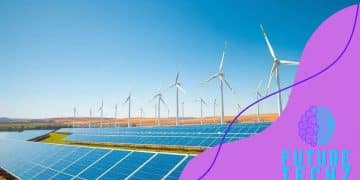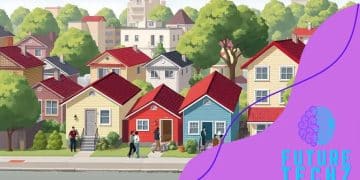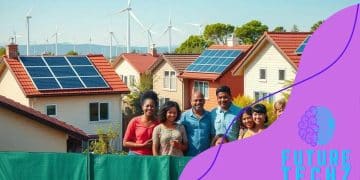Smart city infrastructure powered by renewable energy
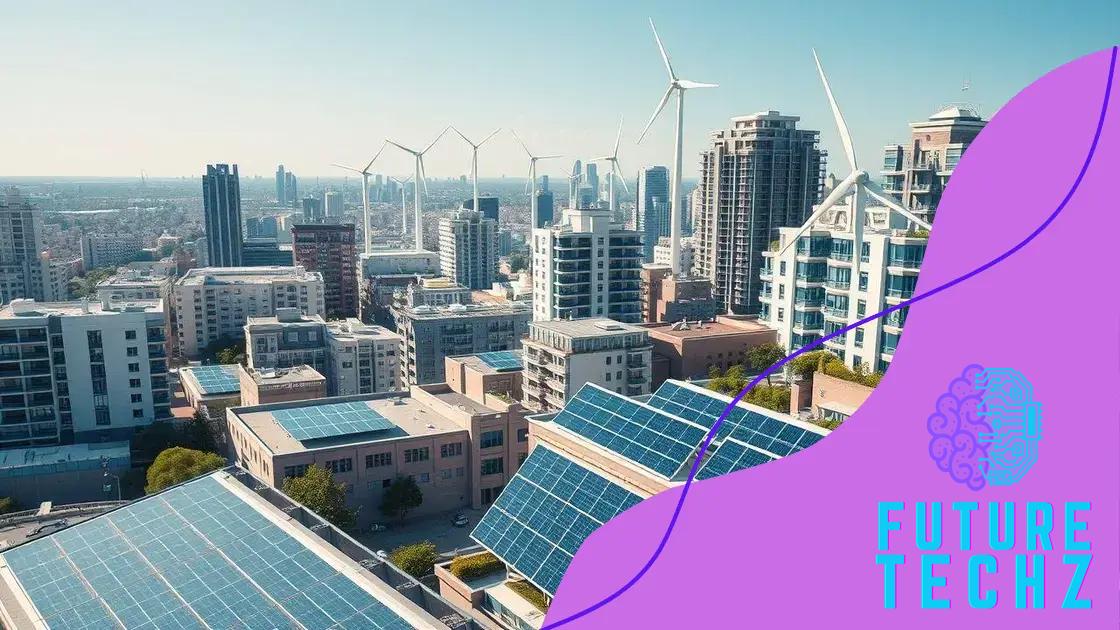
Smart city infrastructure powered by renewable energy enhances urban living by integrating technology to improve efficiency, sustainability, and quality of life for residents, while addressing challenges and future trends in urban development.
Smart city infrastructure powered by renewable energy is not just a buzzword; it’s a vision for sustainable urban living. How are cities adapting to this trend? Let’s dive in.
Key components of smart city infrastructure
The key components of smart city infrastructure are essential for transforming urban environments. These components work together to enhance the quality of life, manage resources wisely, and facilitate connectivity.
1. IoT Devices
Internet of Things (IoT) devices play a crucial role in smart cities. They enable real-time data collection and communication between various city systems. For example, smart traffic lights can adjust based on traffic flow, improving overall transportation efficiency.
2. Renewable Energy Sources
Integrating renewable energy sources such as solar and wind power is vital. This not only reduces carbon emissions but also promotes sustainable energy solutions for urban areas. Cities that utilize these sources can lower their energy costs and reliance on fossil fuels.
3. Smart Transportation Systems
- Public transit that uses real-time updates.
- Electric vehicles and charging stations.
- Bike-sharing programs to reduce traffic congestion.
These systems improve mobility and reduce environmental impacts. When cities prioritize efficient transportation, they create a more accessible environment for residents.
4. Data Management Platforms
Data management platforms are necessary for processing the vast amounts of information generated in smart cities. They allow authorities to analyze data patterns and optimize services ranging from waste management to emergency response.
By bringing together various technologies and strategies, smart city infrastructure powered by renewable energy can lead to innovative solutions for urban challenges. This holistic approach fosters community resilience and supports sustainable growth.
How renewable energy enhances urban living
Renewable energy plays a crucial role in enhancing urban living by providing sustainable solutions to common urban challenges. It helps cities become more resilient, efficient, and eco-friendly.
Clean Energy Solutions
By utilizing sources like solar, wind, and hydro power, cities can reduce their carbon footprint. Communities are increasingly turning to solar panels on rooftops and wind turbines in open spaces. These clean energy solutions not only lower electricity bills but also contribute to a healthier environment.
Improved Air Quality
Transitioning to renewable energy significantly improves air quality. Unlike fossil fuels, renewable sources produce minimal emissions. This means less air pollution, which is crucial for the health of urban residents, especially children and the elderly.
Economic Benefits
- Job creation in renewable energy sectors.
- Lower operational costs for local businesses.
- Attracts investments for sustainable projects.
The shift to renewable energy sources can stimulate local economies and encourage innovation. Cities that invest in green technologies often see a surge in job opportunities and new businesses that focus on sustainability.
Community Engagement
Renewable energy initiatives encourage community engagement. Residents can participate in local energy projects, making them feel more connected to their neighborhoods. This involvement fosters a sense of ownership and responsibility for the environment.
As urban areas continue to adopt renewable energy solutions, the enhancement of city life becomes evident. Cities can thrive, ensuring a sustainable future for generations to come.
Case studies of successful smart cities
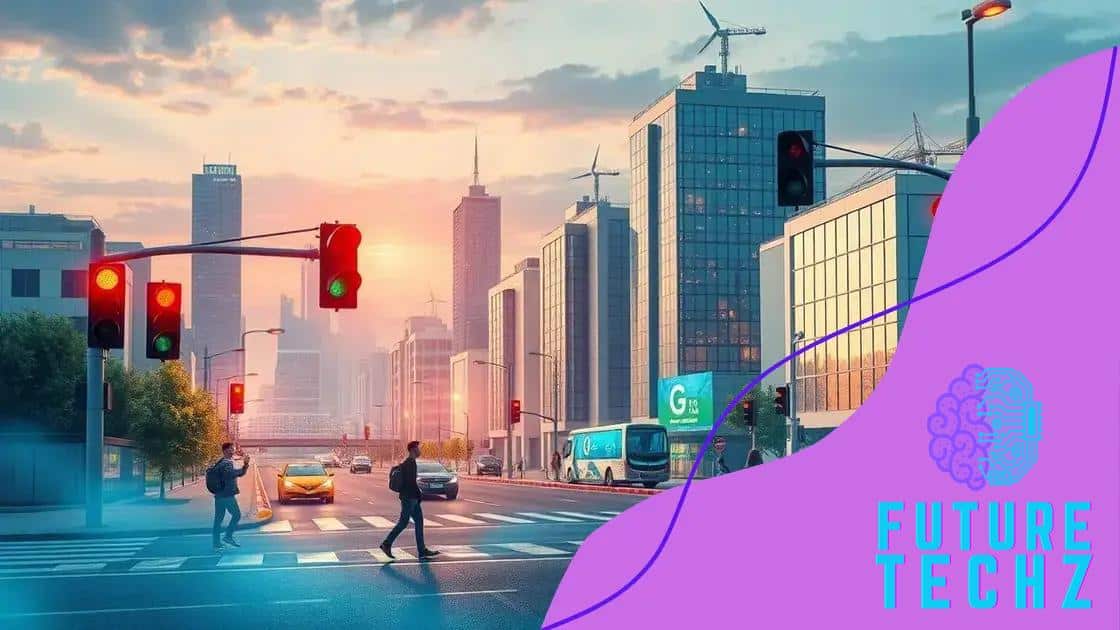
Examining case studies of successful smart cities reveals how innovative practices can lead to significant improvements in urban living. Cities across the globe are adopting technologies that enhance efficiency, sustainability, and the quality of life for their citizens.
1. Barcelona, Spain
Barcelona is renowned for its intelligent urban design. The city utilizes smart lighting and waste management systems that optimize resource use. Smart sensors help manage street lighting, dimming lights when streets are empty, which conserves energy. Additionally, Barcelona’s waste bins are equipped with sensors that notify collection services when they are full, reducing unnecessary pickups.
2. Singapore
Singapore stands out for its comprehensive use of data analytics and Internet of Things (IoT) technologies. The city-state’s Smart Nation Initiative includes wide-ranging applications such as traffic management and environmental monitoring. Smart traffic lights adjust based on real-time traffic conditions, which helps reduce congestion and enhance mobility.
3. Amsterdam, Netherlands
Amsterdam is a leader in sustainability thanks to its renewable energy initiatives. The city has integrated solar panels throughout various infrastructure and promotes electric vehicle use by providing ample charging stations. With a focus on green technology, Amsterdam aims to become carbon-neutral by 2025, setting a benchmark for other cities.
4. Toronto, Canada
Toronto’s Quayside project showcases how smart urban development can incorporate sustainability into design. Featuring energy-efficient buildings and green spaces, Quayside integrates advanced technology for utility management, ensuring efficient use of resources. This project emphasizes community involvement, inviting residents to participate in planning processes.
These case studies exemplify how implementing smart technologies can transform urban environments. Through sustainable practices and community engagement, cities can enhance the living experience while addressing environmental challenges.
Challenges in implementing renewable energy solutions
Implementing renewable energy solutions in cities comes with various challenges that need to be addressed. Understanding these obstacles is crucial for creating effective strategies.
1. High Initial Costs
One major challenge is the high upfront cost associated with renewable energy infrastructure. Technologies like solar panels and wind turbines require significant investment. Although costs are decreasing, financing remains a barrier for many municipalities.
2. Infrastructure Limitations
Many cities still rely on outdated energy infrastructure. Upgrading existing systems to accommodate renewable resources can be difficult. This includes integrating smart grids that manage energy distribution effectively. Cities must carefully plan to ensure a smooth transition.
3. Regulatory Barriers
- Complicated permitting processes can delay project timelines.
- Inconsistent policies at local, state, and federal levels can hinder implementation.
- Lack of supportive regulations can create uncertainty for investors.
These regulatory challenges can slow down progress and discourage potential investments in renewables. Clear, cohesive policies are essential for fostering growth in this sector.
4. Public Awareness and Acceptance
Many residents may not fully understand the benefits of renewable energy. This can lead to skepticism and resistance to change. Educating the public about the advantages, such as environmental impact and cost savings, is vital. Community engagement helps build support for renewable projects.
Overcoming these challenges requires collaboration among government bodies, private sectors, and local communities. By addressing the barriers to implementing renewable energy solutions, cities can make substantial progress toward sustainability.
Future trends in smart city development
Exploring future trends in smart city development reveals how technology will shape urban living. As cities evolve, innovative solutions will enhance sustainability and improve quality of life.
1. Increased Connectivity
Future smart cities will see an even greater reliance on interconnected systems. With the rise of 5G technology, devices will communicate faster and more efficiently. This connectivity will enable smart transportation, better public services, and improved resource management.
2. Enhanced Data Analytics
Data drives decisions in smart cities. Advanced analytics will allow city planners to analyze real-time data more effectively. This will assist in predicting trends and responding to residents’ needs quickly. By utilizing data, cities can optimize energy usage and reduce waste.
3. Emphasis on Sustainability
- Integration of green spaces to improve air quality.
- Use of renewable energy sources to power urban infrastructure.
- Increased focus on reducing carbon footprints across all city sectors.
As sustainability becomes a priority, cities will explore new methods to incorporate green technologies into their designs. This shift will create healthier environments for residents while reducing environmental impacts.
4. Smart Mobility Solutions
The future of transportation is set to change significantly. Smart mobility solutions such as autonomous vehicles, electric shuttles, and integrated public transport systems will reshape urban travel. Cities will focus on reducing traffic congestion and increasing access to public transit.
By embracing these trends, smart cities can enhance urban living, ensuring sustainable and efficient environments for future generations. Collaboration among governments, businesses, and communities will be essential for turning these visions into reality.
FAQ – Frequently Asked Questions about Smart City Infrastructure and Renewable Energy
What are the main benefits of smart city infrastructure?
Smart city infrastructure enhances efficiency, reduces waste, and improves the quality of life for residents by integrating technology and sustainability.
How does renewable energy impact urban living?
Renewable energy reduces carbon footprints, improves air quality, and can lower utility costs, contributing to healthier and more sustainable urban environments.
What challenges do cities face when implementing renewable energy solutions?
Challenges include high initial costs, infrastructure limitations, regulatory barriers, and the need for public awareness and acceptance.
What future trends can we expect in smart city development?
Future trends include increased connectivity, enhanced data analytics, a focus on sustainability, and smart mobility solutions that improve urban transportation.
